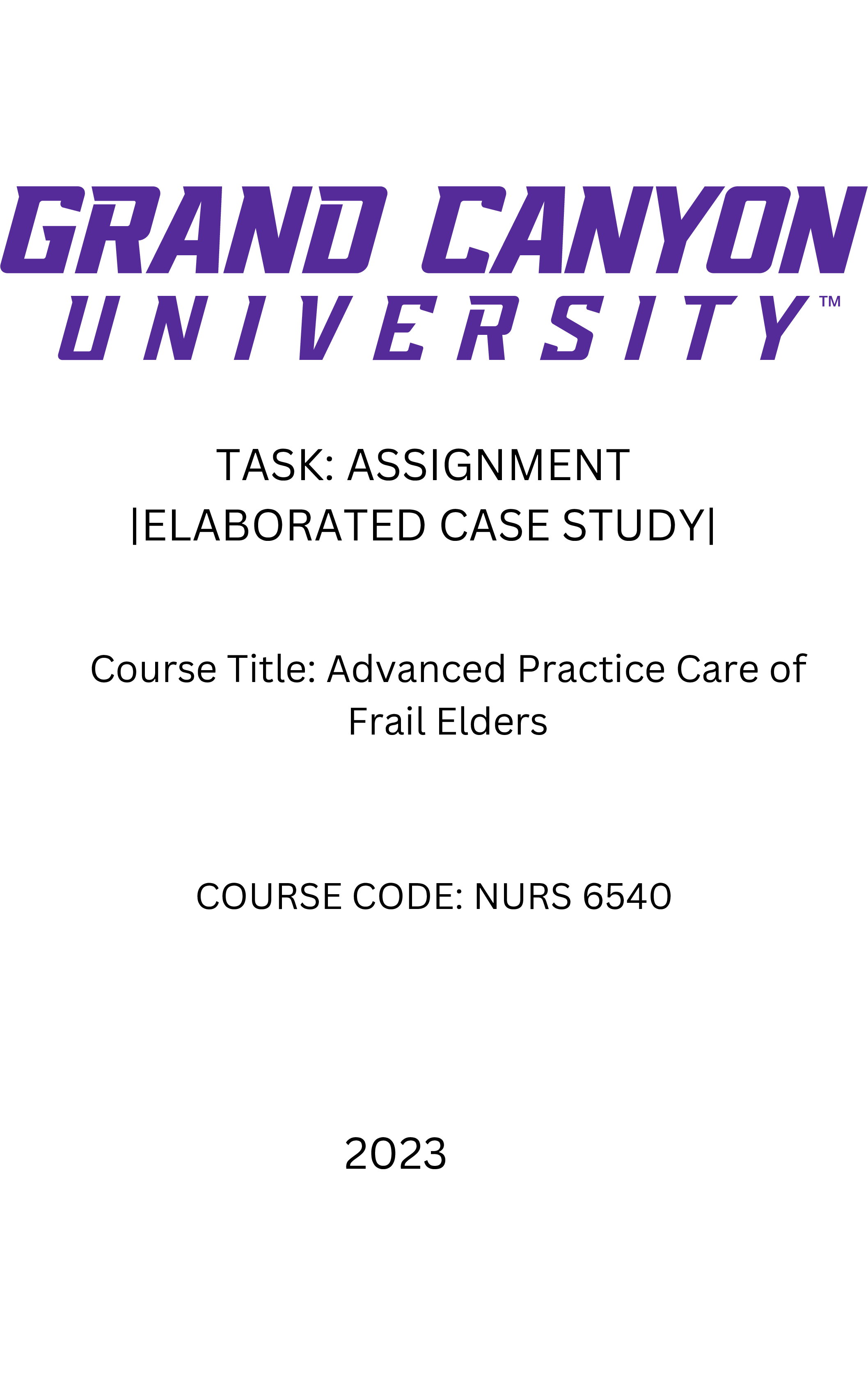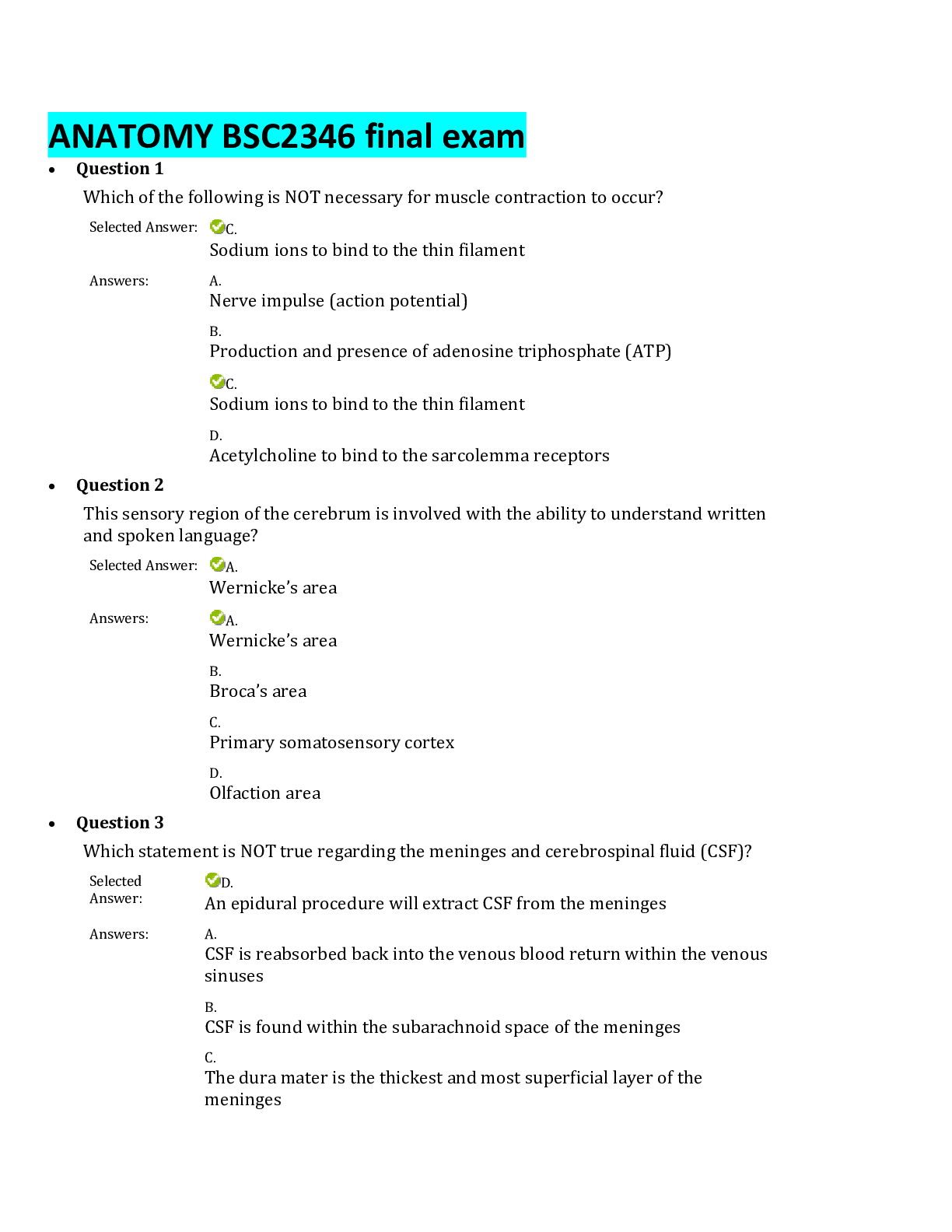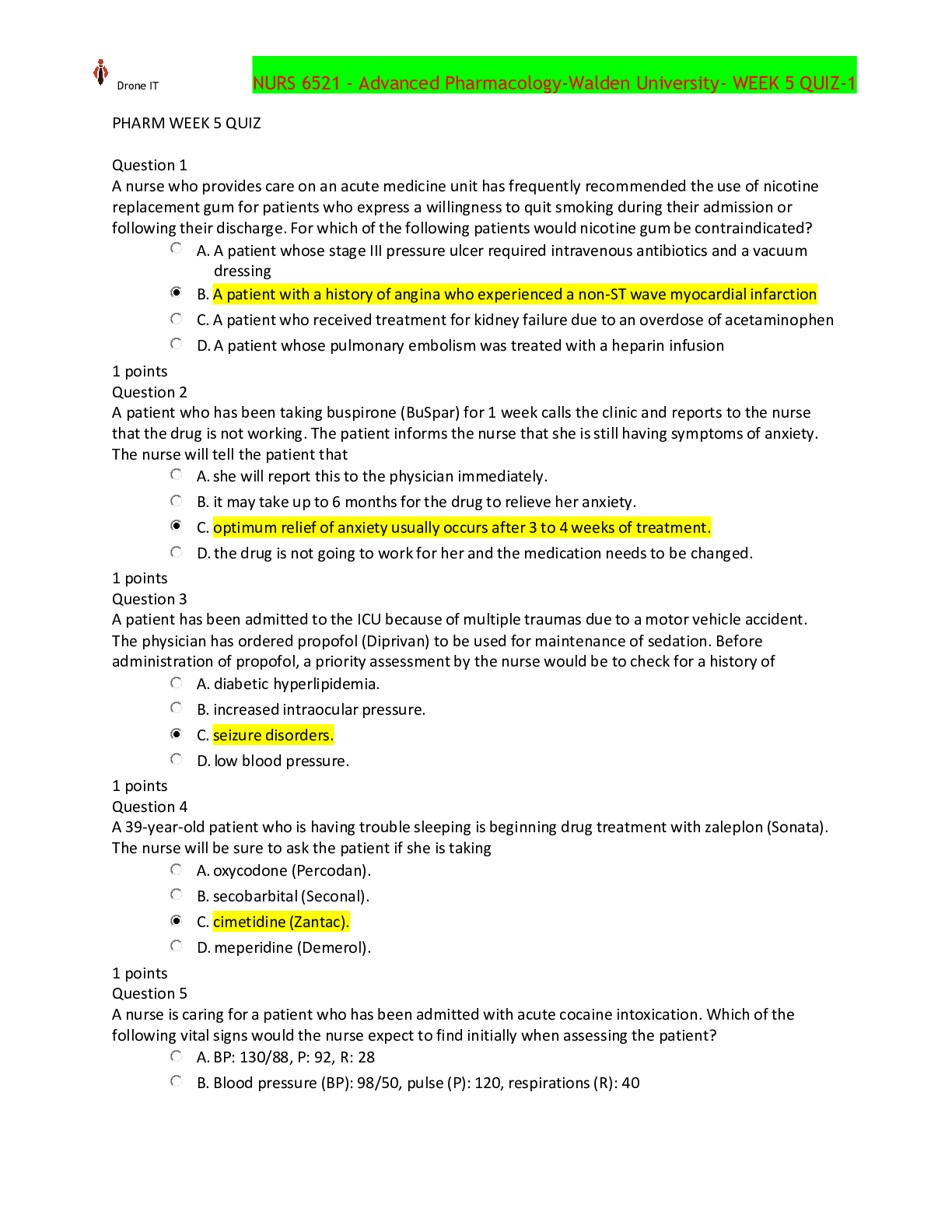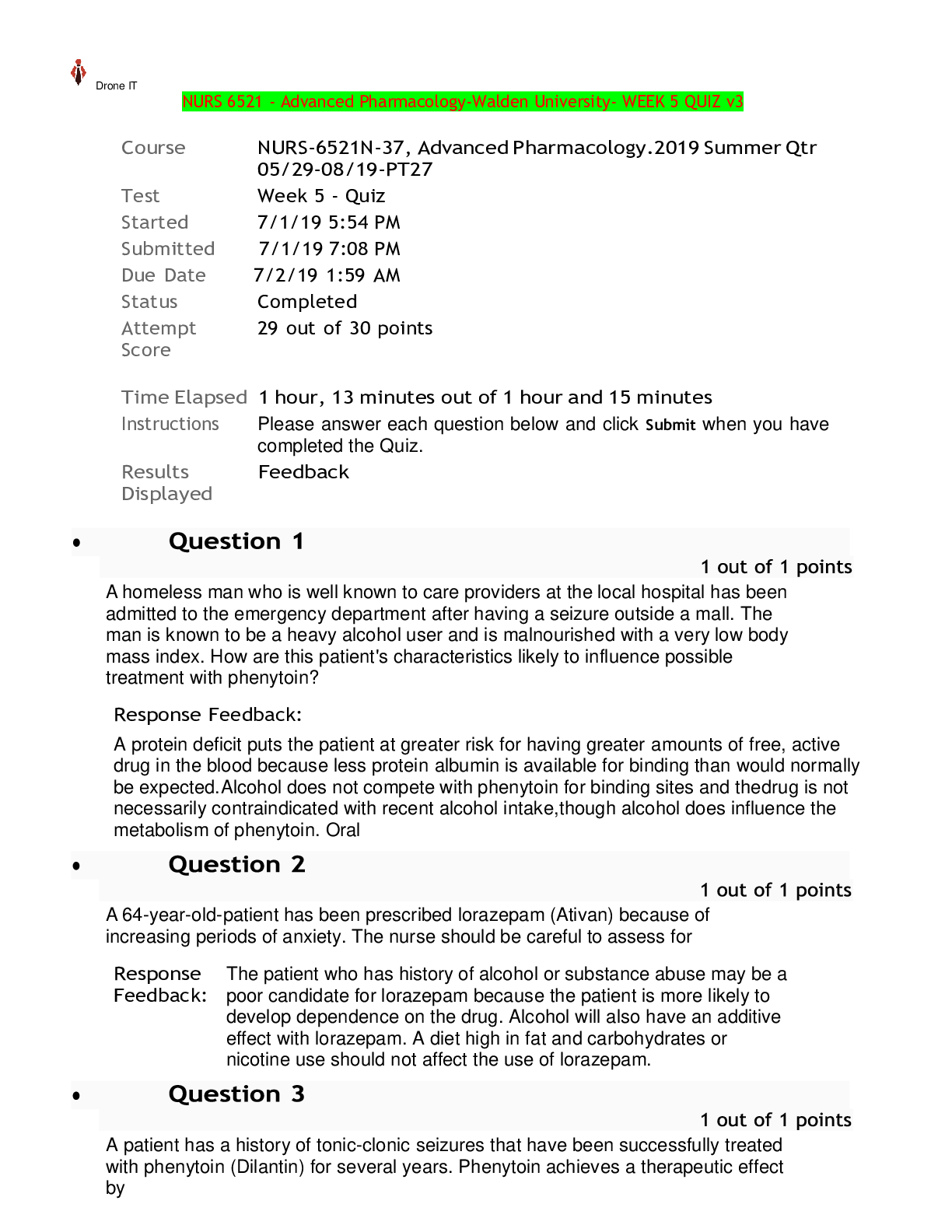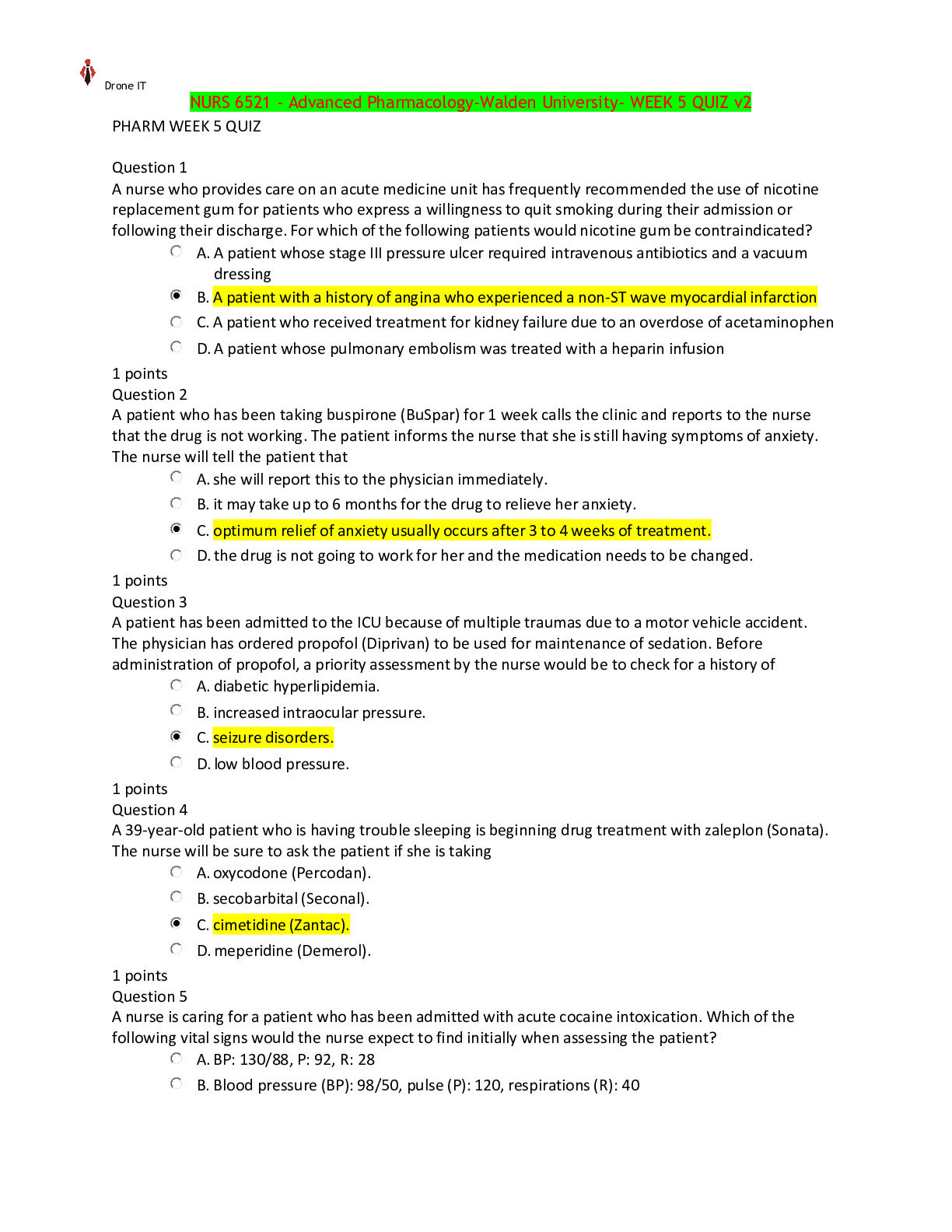Cardiology > EXAM > SOLVED- ELABORATED-American Heart Association-Advanced Cardiovascular Life Support ACLS Written Exam (All)
SOLVED- ELABORATED-American Heart Association-Advanced Cardiovascular Life Support ACLS Written Exam-Practice Questions-2022
Document Content and Description Below
SOLVED- ELABORATED-American Heart Association-Advanced Cardiovascular Life Support ACLS Written Exam-Practice Questions-2022 1. In which situation does bradycardia require treatment? -Ans| >> Hypoten... sion 2. Which intervention is most appropriate for the treatment of a patient in asystole? -Ans| >> Epinephrine 3. You arrive on the scene with the code team. High-quality CPR is in progress. An AED has previously advised "no shock indicated." A rhythm check now finds asystole. After resuming high-quality compressions, which action do you take next? -Ans| >> Establish IV or IO access 4. A monitored patient in the ICU developed a sudden onset of narrow-complex tachycardia at a rate of 220/min. The patient's blood pressure is 128/58 mm Hg, the PETCO2 is 38mm Hg, and the pulse oximetry reading is 98%. There is vascular access in the left arm, and the patient has not been given any vasoactive drugs. A 12-lead ECG confirm a supraventricular tachycardia with no evidence of ischemia or infarction. The heart rate has not responded to vagal maneuvers. what is your next action? -Ans| >> Administer adenosine 6mg IV push 5. A patient has sinus bradycardia with a heart rate of 36/min. Atropine has been administered to a total does of 3 mg. A transcutaneous pacemaker has failed to capture. The patient is confused, and her blood pressure is 88/56 mm Hg. Which therapy is now indicated? -Ans| >> Epinephrine 2 to 10 mcg/min 6. A patient is in cardiac arrest. Ventricular fibrillation has been refractory to a second shock. Which drug should be administered first? -Ans| >> Epinephrine 1 mg IV/IO 7. A 62-year-old man suddenly experienced difficulty speaking and left-sided weakness. He meets initial criteria for fibrinolytic therapy, and a CT scan of the brain si ordered. Which best describes the guidelines for antiplatelet and fibrinolytic therapy? -Ans| >> Hold aspirin for at least 24 hours if rtPA is administered 8. A patient is in refractory ventricular fibrillation and has received multiple appropriate defibrillation shocks, epinephrine 1 mg IV twice, and an initial dose of amiodarone 300mg IV. The patient is intubated. Which best describe the recommended second does of amiodarone for this patient? -Ans| >> 150 mg IV push 9. A patient with sinus bradycardia and a heart rate of 42/min has diaphoresis and a blood pressure of 80/60mm Hg. What is the initial does of atropine? -Ans| >> 0.5mg 10. A 35-year-old woman has palpitations, light-headedness, and a stable tachycardia. The monitor shows a regular narrow-complex QRS at a rate of 180/min. Vagal maneuvers have not been effective in terminating the rhythm. An IV has been established. Which drug should be administered? -Ans| >> Adenosine 6mg 11. A patient is in cardiac arrest. Ventricular fibrillation has been refractory to an initial shock. If no pathway for medication administration is in place, which method is preferred? -Ans| >> IV or IO 12. What is the indication for the use of magnesium in cardiac arrest? -Ans| >> Pulseless ventricular tachycardia-associated torsades de pointes 13. A patient has a rapid irregular wide-complex tachycardia. The ventricular rate is 138/min. He is asymptomatic, with a blood pressure of 110/70 mm Hg. He has a history of angina. What action is recommended next? -Ans| >> Seeking expert consultation 14. A patient is in cardiac arrest. High-quality chest compressions are being given. The patient is intubated, and an IV has been started. The rhythm is asystole. What is the first drug/dose to administer? -Ans| >> Epinephrine 1mg IV/IO 15. A patient is in refractory ventricular fibrillation. High-quality CPR is in progress. One does of epinephrine was given after the second shock. An antiarrhythmic drug was given immediately after the third shock. You are the team leader. Which medication do you order next. -Ans| >> Epinephrine 1 mg 16. A patient with possible STEMI has ongoing chest discomfort. What is a contraindication to nitrate administration? -Ans| >> Use of a phosphodiestrase inhibitor within the previous 24 hours 17. A 57-year-old woman has palpitation, chest discomfort, and tachycardia. The monitor shows a regular wide-QRS at a rate of 180/min. She becomes diaphoretic, and her blood pressure is 80/60 mm HG/ Which action do you take next? -Ans| >> Perform electrical cordioversion 18. A patient with STEMI has ongoing chest discomfort. Heparin 4000 units IV bolus and a heparin infusion of 1000 units per hour are being administered. The patient did not take aspirin because he has a history of gastritis, with was treated 5 years ago. What is your next action? -Ans| >> Give aspirin 160-325 mg to chew 19. You are caring for a 66-year-old man with a history of a large intracerebral hemorrhage 2 months ago. He is being evaluated for another acute stroke. The CT scan is negative for hemorrhage. The patient is receiving oxygen via nasal cannula at 2L/min, and an IV has been established. His blood pressure is 180/100mm Hg. Which drug do you anticipate giving to this patient? -Ans| >> Aspirin [Show More]
Last updated: 2 years ago
Preview 1 out of 30 pages

Buy this document to get the full access instantly
Instant Download Access after purchase
Buy NowInstant download
We Accept:

Reviews( 0 )
$14.50
Can't find what you want? Try our AI powered Search
Document information
Connected school, study & course
About the document
Uploaded On
May 11, 2023
Number of pages
30
Written in
Additional information
This document has been written for:
Uploaded
May 11, 2023
Downloads
0
Views
95

